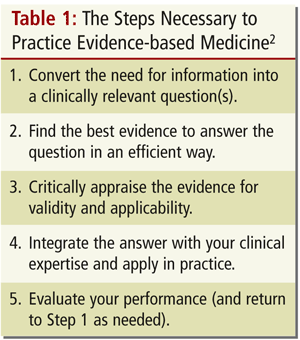Evidence in the Palm of Your Hand: Using PDAs to Implement Clinical Practice Guidelines in Primary Care
D'Arcy Little, MD, CCFP, Lecturer and Academic Fellow, Department of Family and Community Medicine, University of Toronto, ON.
"The best predictor of successful guideline implementation is the provision of guideline-based recommendations that are patient specific at the time and place of the patient consultation."1
The need for relevant and timely information at the point of patient care is paramount in primary medicine. The routine care of patients necessitates having, at the clinician's fingertips, up to date information about the diagnosis, prognosis and treatment of many illnesses.2 In fact, it is estimated that two important clinical questions are generated for every three patients seen in the office.2,3 However, it is increasingly difficult to keep up to date; physicians who want to keep up with relevant journals in their field would need to review 19 articles per day, 365 days per year.2,4
The development and dissemination of clinical practice guidelines (CPGs) is one attempt to consolidate and make available information that clinicians can easily use in clinical decision-making.5 However, many guidelines may be in a format that is not user-friendly for busy daily practice.6,7 The purpose of this article is to review the role of Personal Digital Assistants (PDAs) in the implementation of CPGs, including a review of the available evidence for this practice.
 PDAs and Evidence-Based Medicine
PDAs and Evidence-Based Medicine
It is important to note that the use of PDAs does not replace any of the steps involved in practising evidence-based medicine (EBM), but it may make some of them easier. Table 1 reviews the steps devised by Straus and Sackett that are necessary to practice EBM.2 PDAs have the potential to make the best evidence available at the point of care in a fast and easily digestible format,6 thus facilitating steps 2, 3 and 4.
Barriers to Guideline Implementation
The four-stage Pathman Model has been used to delineate the barriers that exist in guideline implementation. The steps include awareness, agreement, adoption and adherence.8 For a guideline to be implemented, a physician must become aware of the guideline, then intellectually agree with it, decide to adopt it in the care he provides, and finally regularly adhere to it at appropriate times.9 Some physicians consider clinical guidelines to be akin to "cookbook medicine". As such, they balk at the idea of using decision support tools in their practice.10 PDAs may not leverage these physicians at the agreement stage; however, PDAs may have a role in the other three steps of guideline implementation.
Evidence for the Use of PDAs for Guideline Implementation
Approximately 30% of physicians now use PDAs, a number expected to increase to 50% by 2005.11 A recent systematic review of PDA use in medicine has acknowledged that despite the explosion in their use, there is a paucity of evidence-based information.12 The available evidence is discussed here.
Sackett and Straus have shown that the availability of a mobile "evidence cart"--consisting of EBM and medical reference material stored in laptops or paper inventories--in a busy inpatient medical service increased the extent to which evidence was sought and used in patient care decisions.13,14 However, the cart was found to be too bulky to take on bedside rounds. PDAs have the potential to serve as an optimally-mobile "evidence cart". Commonly used medical applications for PDAs include textbooks, rules and calculators, pharmacopoeias as well as scheduling and patient tracking programs. Recently, sites which have CPGs in PDA format also have become available ("A Brief Guide to Some Free Evidence-based Medicine Resources for the PDA" is available online at www.geriatricsandaging.ca).
Because many of the studies describing the use of PDAs in implementing guidelines are continuing, often only descriptive reports
